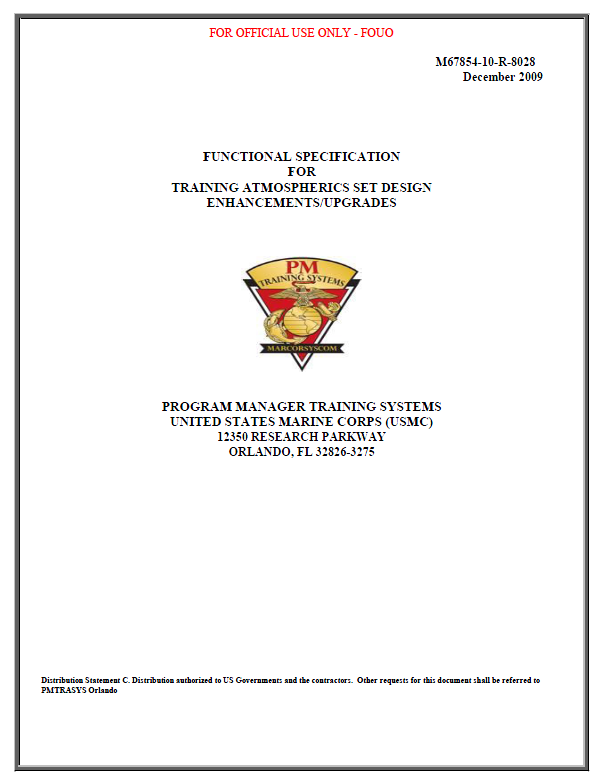 PROGRAM MANAGER TRAINING SYSTEMS UNITED STATES MARINE CORPS (USMC)
PROGRAM MANAGER TRAINING SYSTEMS UNITED STATES MARINE CORPS (USMC)
- M67854-10-R-8028
- For Official Use Only
- December 2009
1. SCOPE
This specification establishes the functional capabilities for the atmospherics set design training enhancements effort. This specification is required to enhance and upgrade existing and future USMC Military Operation in Urban Terrain (MOUT), Home Station Training (HST) areas and Ranges. Even though these areas are typically equipped with streets, courtyard walls, mosques, buildings, and village shanties, the atmosphere is void of detailed cultural realism such as items listed. Specifically, this specification will provide the detailed information required for placing, updating or enhancing spaces and places within the training areas.
1.1 Background
The United States Marine Corps (USMC) has an immediate requirement to enhance and upgrade existing and future USMC Military Operation in Urban Terrain (MOUT); Home Station Training (HST) areas and Ranges. Currently, the existing MOUT and planned HST area facilities and surrounding range areas are void of cultural realism. Even though these areas are equipped with streets, courtyard walls, mosques, buildings, and village shanties, the atmosphere is void of detailed cultural realism such as “prop” like items (furniture, billboards, fake foodstuffs, ersatz crops, colors and mud brick facades etc.) utilized during training scenarios.
…
3.1.1.1 Market
A culturally accurate market design that takes in effect the culture being replicated, materials typically found in that replication that differentiates one market shop design from other designs i.e., signage, materials (faux or real) being displayed and markings, and smells. The design should affect all five senses from the standpoint of replicating, to the level of design (specified in the DO), as close as possible the desired cultural setting.
This specification includes following types of market shops:
Carpet/Rug
Souvenir
Hardware
Furniture
Office supply
Textile/LinenBakery
Clothing
Electronic
Butcher
Appliance
Drug…
3.1.1.2 Carts
A culturally accurate 2, 3, or 4 wheeled cart design dependent upon design. Carts must be:
- A vendor type of market handcart or animal pulled cart consistent with culture being replicated.
- Operational; painted; and decorated in a variety of ways consistent with culture.
- Mobile and movable by hand by one person. Anchored in place so that they cannot move involuntarily. However, they must be capable of being moved with minimum of effort.
- All items on the cart shall be secured to the cart such that they cannot fall or blow off by 35 mph winds.
Designed to replicate the following possible types:Spice/Tea/Grain
Fruit/Vegetables
Textile/Linen
Carpet
Flowers
Clothing
Magazine
Hardware
Tobacco
Bakery
Souvenir
Pots/pans/Tins
Butcher (Faux Meats)
Drug
Electronic
Faux Ice
Faux FishThe Contractor shall deliver various types of simulated canned; boxed; or sacks of food stuffs. For example:
Tea(s)
Meats
Spices
Dates
Sugar
Nuts
Tobacco
Fruits
Breads
VegetablesThe Contractor shall deliver various types of household and kitchen items. For example:
Faux kerosene
Firewood
Tea pots
Knives
Large cooking vats/Kettle
Tea cups
Pots/pans
5-gallon cooking oil cans
Cooking and eating utensils
Cooking apparatus
Platters
Smoking Pipe
Household detergents
Plates and bowls
Faux meats
Drinking cups
- All items stored in bulk will have containers i.e., wooden barrels, baskets, crates, plastic or metal buckets as required.
- All foodstuffs should be non-perishable or simulated, and should consist of a wide variety of types and sizes.
- All items provided shall be free of fluids, hazardous materials and fire hazards before delivery.
- All books and magazines will be language to include symbols and writing appropriate consistent with culture.
…
3.1.1.8 Mosque
A Mosque interior environment design has a prayer hall, also known as the musalla with no furniture; chairs and pews are absent from the prayer hall so as to allow as many worshipers as possible to line the room. All items included in the design shall be such that it is done with the sensitivity of the culture being replicated. The set contains décor elements such as:
prayer rugs
minbar or pulpit
carpets
mihrab
fabric banners with painted verses of the Qur’an (or Koran)
entryway ablution fountains
benches
foyer shelves to put shoes
wooden tables
foyer racks to hold coats
faux Qur’an
lectern
- Arabic calligraphy and Qur’anic verses on the walls to assist worshippers in focusing on the beauty of Islam and its holiest book, the Qur’an, as well as for decoration.
- The minbar is usually shaped like a small tower with a pointed roof and stairs leading up to it.
- The minbar is located to the right of the mihrab, the niche that indicates the direction of prayer (i.e. towards Mecca).
- A mihrab is a niche in the wall of a mosque that indicates the qibla; that is, the direction of the Kaaba in Mecca and hence the direction that Muslims should face when praying.
- A minbar is ornately decorated and often designed to give the impression of an arched doorway or a passage to Mecca.
- The wall in which a mihrab appears is thus the “qibla wall.”
- A lectern is a reading desk with a slanted top, usually placed on a stand or affixed to a some other form of support, on which documents or books are placed as support for reading aloud, as in a scripture reading, lecture, or sermon.
…
- Water fountains shall be culturally accurate, precast and delivered and set up in the space provided. The fountain may be a part of a courtyard or a standalone place to draw water for the community.
…
- Acoustics (actual sounds) with compact disks that contain cultural sounds of village being replicated.
…

